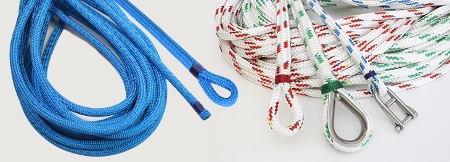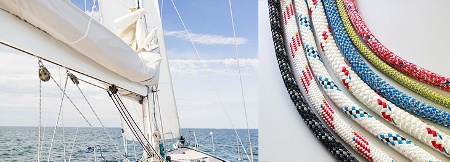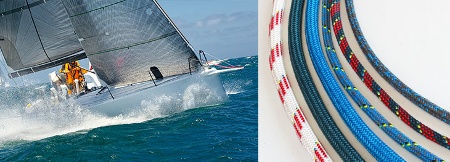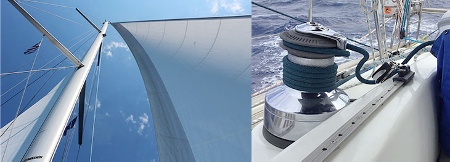How to Choose a New Halyard
Whether you are cruising, performance cruising, or racing, choosing a new halyard could be one of the most important decisions you make. The main criteria of Stretch, Strength, Durability, Abrasion Resistance, Handling and Grip are discussed in this article.
Published 10 months ago, updated 6 months ago
Budget
Unless money is no object, budget will be a major factor in the decision-making process. The price increases with the specification, so lower stretch, higher strength and better durability mean more expense. Lower stretch enhances VMG (velocity made good), and higher strength tends to come with it. Durability amortises your outlay over a longer period. For extended cruising, buying the best you can afford will reward you on both those counts: performance and endurance.


Stretch
There are two kinds of elongation in a manufactured line:
- The natural extension of the fibre – Nylon, Polypropylene and Spun Polyester are naturally stretchy, while Dyneema and Vectran are not – High Tensile Monofilament Polyester can be engineered into a low-stretch rope. Rope Manufacturers also use a heat setting process, further reducing the natural tendency to lengthen under load.
- Constructional Extension – the configuration of the strands or plaits will gradually settle into their elongated form after a bedding-in period – So you should anticipate a ‘running in’ period for your new halyards to achieve their lowest possible stretch. This is more evident with 100% polyester lines. It will be less noticeable with High-tech fibres such as Dyneema and Vectran.


Will you be Cruising, Performance Cruising, or Racing?
Cruising Rigs are not generally designed to withstand extreme loads, so it isn’t necessarily a good idea to go for super-low stretch, super high-strength lines because they can transfer the stress to parts of the rig and deck hardware which may not be designed to take the strain.
A certain amount of ‘give’ will reduce this effect, extending the working life of all the rigging and leading to less frequent replacement costs.
Performance Cruising is that middle path between cruising and racing, looking for faster, more efficient passage-making without causing too much strain on the crew or the rig.
Offshore Racing Rigs are designed to withstand and utilise extreme forces, so top-specification ultra-low stretch lines can be applied to transfer the wind energy as directly as possible into boat speed.


Upwind Sails – Jib, Genoa, Main
Halyards for upwind sails (wind forward of the beam) should have the minimum stretch possible within your budget. Manage your expectations by judging how important sailing efficiency and a ship-shape rig are to you. Minimising the line extension is critical to achieving a tight luff (leading edge). Maintaining luff tension is crucial to sail shape and pointing performance.
If the line is not low stretch, it will eventually lengthen under load, regardless of how hard you try when you first hoist the sail. The gradual lapse in tautness is generally known as sag. You can winch a line until it is bar tight, but if it isn’t a sufficiently low stretch line, it will eventually slacken and you will need to apply more tension repeatedly. If you are happy to give the halyard an occasional tweak, a 100% polyester line will suit you fine.
Downwind Sails, including Reaching – Code Zero, Gennaker, Spinnaker
Stretch is not so critical in halyards for reaching sails (wind across the beam) and less important for downwind sails (wind aft of the beam) because they don’t rely on a bar-tight luff to achieve their design effectiveness.
A note on 2:1 Purchase Halyards
2:1 Pros
- Effective at reducing stretch and load on the line
- May allow a reduction in line diameter
2:1 Cons
- Increase in cost, the line will be 40%-50% longer
- The extra line will need to be managed at the mast base or in the cockpit
- The effort and time required to hoist the sail are significantly increased
Conclusion – a higher performance lower stretch line in a regular 1:1 system may represent better value.
Strength
If the correct diameter is selected for the application, a good quality halyard rope should have sufficient break load capacity for the job.
100% polyester lines are fine for cruising yachts, but a Dyneema core will deliver higher strength and reduce the strain compared with the applied force.
Rope Manufacturers publish average or ultimate break loads as a guide, but these don’t generally refer to Safe Working Loads.
Strength does still help though, because, for any given application, a stronger line will reduce the strain as a proportion of the rated break load, resulting in a better safety factor and slightly reduced stretch. There is also another benefit – lessening the stress on the rope fibres will extend a rope’s working life.
If the line diameter is restricted by the size of the blocks, clutches, and organisers in your deck layout or on your mast, a Dyneema upgrade may be beneficial, but checking all the associated hardware for load-bearing capacity is advisable.
UV Resistance
All rope fibres are affected by prolonged periods in the sun. The speed of the degradation process depends on the rope you choose. If the yacht will not be sailing for a while, it may be worth using mousing lines to remove the halyards from the mast to reduce the amount of exposure.
Polyester and Dyneema both have excellent natural resistance to the sun’s harmful rays. Rope manufacturers also impregnate Dyneema with a polyurethane coating to improve their resilience. UV deterioration is a major consideration for yachts in the Mediterranean and the Tropics.
Abrasion Resistance
On passage, when the rig is working, all the rigging lines will be subject to continual, natural wear where they pass through sheaves, blocks, and clutches. The gradual abrasion will be significantly worse if the routing is improperly specified and aligned. Ensure that the lines make no unnecessary contact with the deck or extraneous hardware as they run through the system because this will also result in chafing, scuffing, or snagging.
It is worth pointing out that the high frequency and velocity of halyard drops and hoists involved in racing any yacht will significantly increase the degree of wear and tear.
For extended cruising, it will be important to adjust the sail settings regularly to vary the sections that are particularly vulnerable to chafe.
Adding an extra anti-chafe sleeve to the vulnerable sections will be well worth the effort and expense, e.g. the halyard tip close to the head of the sail and the part of the line that is constantly in the clutch.
Anti-abrasion properties depend not only on the fibre (Polyester, Technora, Dyneema) but also on the rope design and construction. Generally, more plaits offer a sliding scale of improved wear resistance as follows: 8plait, 16plait, 24plait, 1:1 plait, 32plait.
The closer weave also dramatically reduces the risk of snagging and tearing; for example, 32plait will be superior to 16plait. A tight weave Polyester or Polyester/Technora blended jacket over a Dyneema core will be harder wearing than a 100% Dyneema 12-strand hollowbraid.
Salt ingress can also cause harmful internal abrasion. Regularly washing your lines in fresh water to purge them of the salt will help to prolong a rope’s working life.
Comfort and Handling
The rope fibre, the finished construction and the line diameter combine to determine how comfortable a line feels in your hand. You don’t necessarily have to handle halyards very often on a cruising voyage, but when it comes to a hoist or a drop, there will be a long length to manage and stow.
Coiling and Hanking – Balanced braiding is crucial to producing a non-kinking rope that won’t get snarled into repeated twists and loops. Rope manufacturers go to great lengths to synchronise all the strands to achieve this balance. Don’t ruin it by introducing a twist yourself when you are hanking up a line. Allow a braided line to fall naturally into a figure of eight in your hand to maintain the design symmetry. If you roll your thumb over it as you would with a traditional 3-strand rope, you will introduce an unwanted twist, resulting in a tangled mess when you try to redeploy the line.


Grip
A solid, round, and firm braid-on-braid construction will provide excellent holding power in clutches and jammers. For high-load applications, especially where there is likely to be increased abrasion or to increase the line diameter at critical points, it is possible to sheath the rope with a hollowbraid. Use Dyneema for anti-chafe or Technora for enhanced grip.
The Finished Article
Once you have made your choice, don’t spoil the ship for a ha’porth (half penny worth) of tar. A splice will be the strongest and most secure method for attaching to the sail and a whipping at the other end will maintain the integrity of the line construction, which in turn will mean a greater return on your investment in terms of working life expectancy. A loop formed into the whipping will also be extremely useful for pulling a mousing line through the mast if you need to remove the halyard for any reason. In short, a professional finish will be well worth the extra cost.
The Ten Most Important Points to Consider for a New Halyard:
- Budget
- Cruising, Performance Cruising or Racing
- Upwind or Downwind
- Stretch
- Strength
- Durability
- Abrasion resistance
- Handling
- Comfort
- Professional Finish
…………………………
About the Author
Jimmy Green Marine is a family-run business founded by brothers Alistair and Mike Green, based in the coastal fishing village of Beer in East Devon. The company started as a Mail Order Chandlers in 1981 and has continually evolved from attending Boat Shows and Boat Jumbles in the early days to now trading globally online.


Four decades of exporting experience combined with an intuitive website shipping calculator means that you can have your order delivered to your home, business or direct to your yacht anywhere worldwide.
Their flagship, innovative Custom Build website system provides an instant quote for all your professionally spliced and finished wire and rope rigging, mooring and anchoring solutions.
You can access this online from wherever you can get an internet connection, however remote.
Alistair Green is an experienced sailor and rigger with over 40 years of experience in the marine industry. He is passionate about providing his customers with the best possible products and services and is always looking for new ways to improve the business.
If you are looking for a reliable and experienced marine supplier, then Jimmy Green Marine is the perfect choice.
Visit their website today to learn more about their products and services.
…………………………
Related Links:
- About Jimmy Green Marine
- Custom Splicing, Rigging and Sewing Service
- Worldwide Shipping
- Jimmy Green Marine joins Noonsite.com as Official Ropes and Rigging Partner (April 2023)
Other Articles by Jimmy Green Marine:
- All About Rope Splicing and Whipping (May 2023)
- How to Choose Your Next Anchor Chain (August 2023)
- Ten Reasons to Stitch and Whip Your Ropes (September 2023)
- When to Replace your Standing Rigging (October 2023)
………………………………
The opinions expressed in this article are the author’s own and do not reflect the view of Noonsite.com or World Cruising Club.
………………………………
Find out all news, reports, links and comments posted on Noonsite, plus cruising information from around the world, by subscribing to our FREE monthly newsletter. Go to https://www.noonsite.com/newsletter/.
Related to the following Cruising Resources: Equipment, General, General, Global Yachting Services, Sails & Rigging



